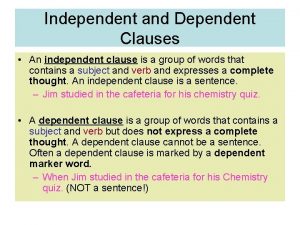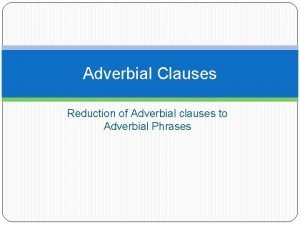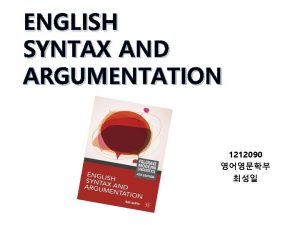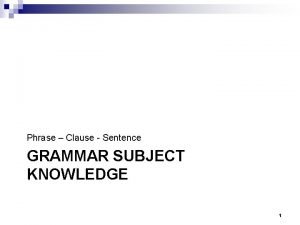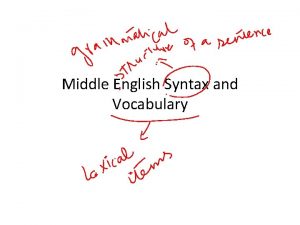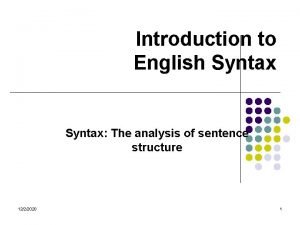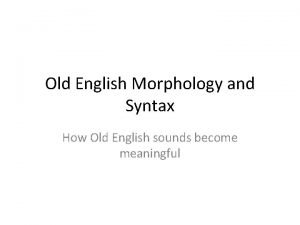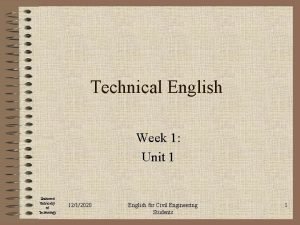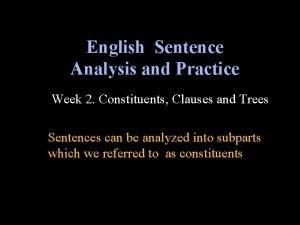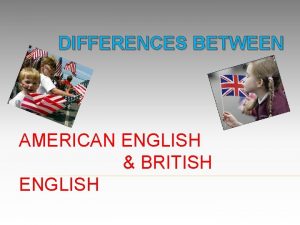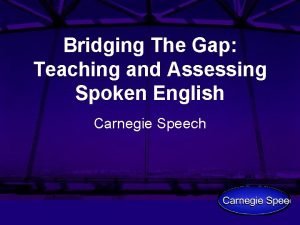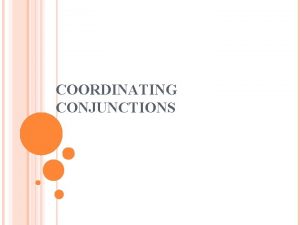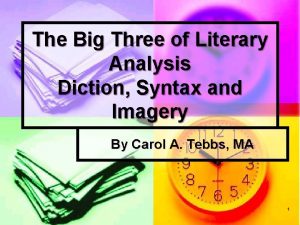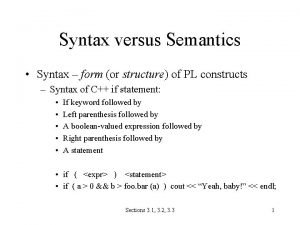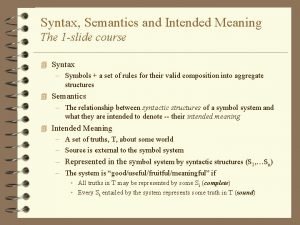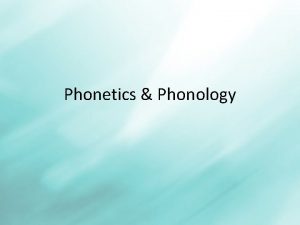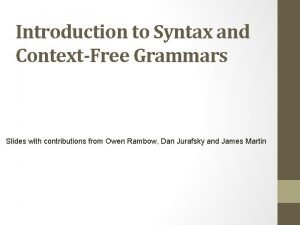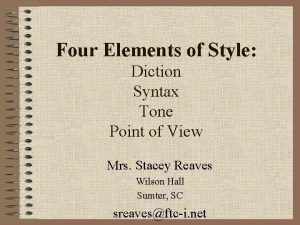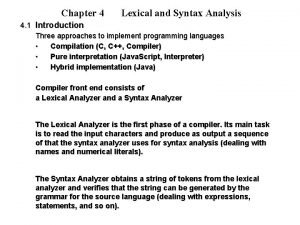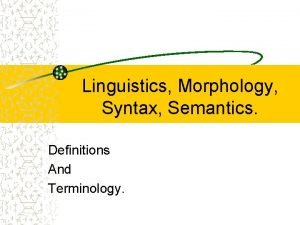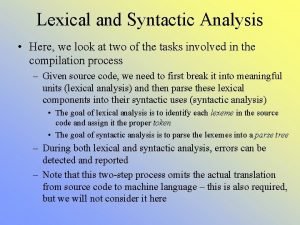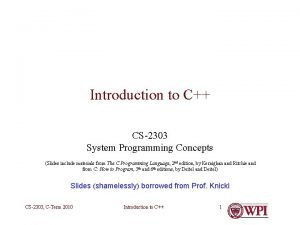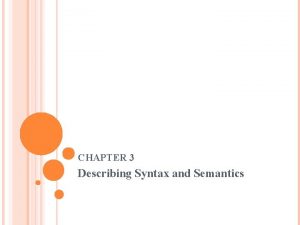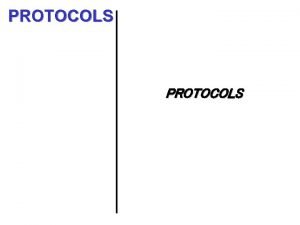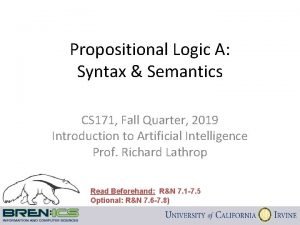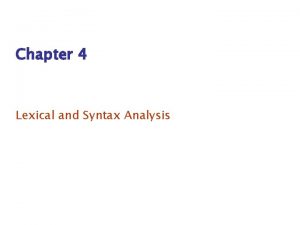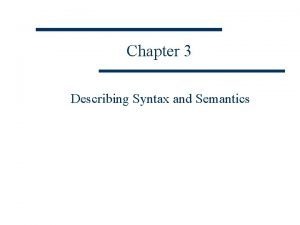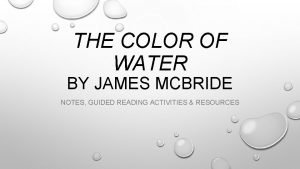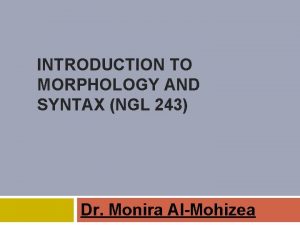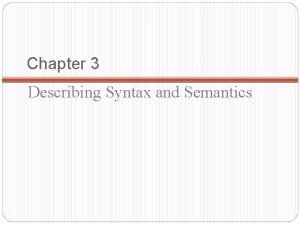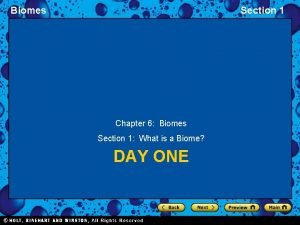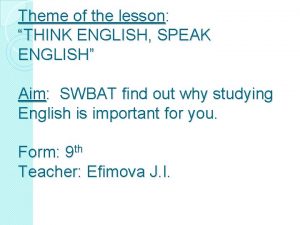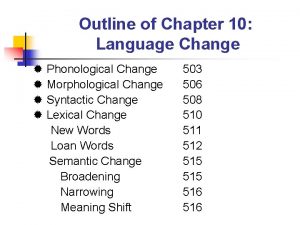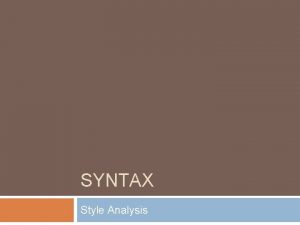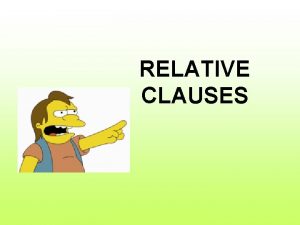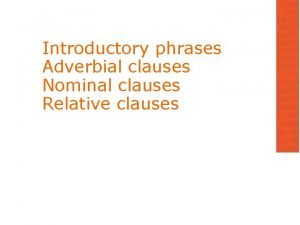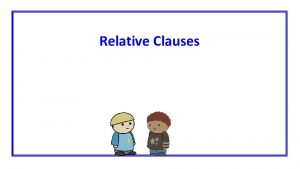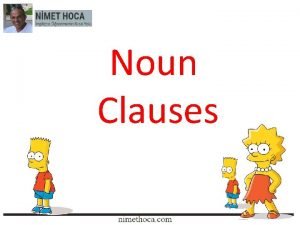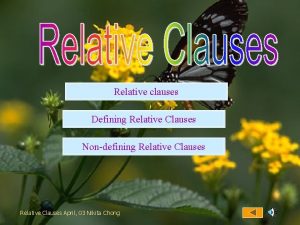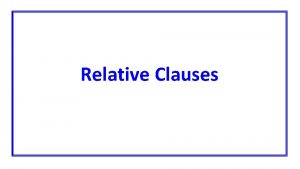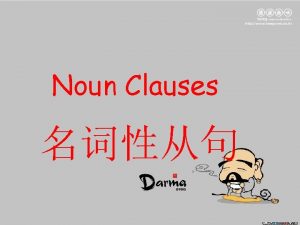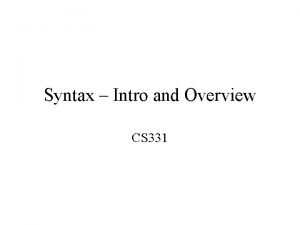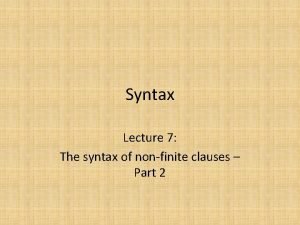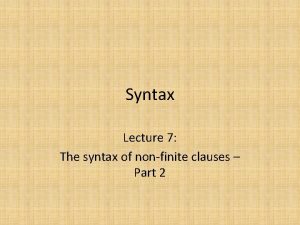English Syntax Week 3 Clauses and Trees Trees





















































- Slides: 53

English Syntax Week 3. Clauses and Trees

Trees and constituency • A sentence has a hierarchical structure • Constituents can have constituents of their own. • The simplest way to draw this is with a tree. PP P on NP D N the table

Trees • The tree diagram is the most important analytical notation we will work with, and we will use a lot of trees through the semester, so it is important to be able to understand draw trees.

Drawing trees • Suppose the task is to draw the tree structure of a simple sentence. – The student put the book on the table.

Drawing Trees The first step is to identify the category of each of the words in the sentence. D The N V student put the D N book on the P D table N

So, we draw an NP above the table, the student, the book. NP NP NP D N The student V put D the N book P on D the N table

Drawing Trees Sure, we can draw in a PP for on the table. Compare this sentence to The student saw the book on the table What is the difference between them with respect to on the table? NP NP D PP N The student V put D NP N the book P on D the N table

Drawing Trees Only one choice is the right choice. How do we know which one it is? Golden Rule of Modifiers: Modifiers are always attached within the phrase they modify. NP ? PP NP D N The student V put D the N book P on D the N table

Drawing Trees Using the idea that the sentence has an NP and a VP, we can complete the tree. VP NP PP NP D N The student V put D the NP N book P on D the N table

Drawing Trees And that’s our tree for The student put the book on the table. (1) S VP NP PP NP D N The student V put D the NP N P book on D the N table

Phrase Structure Rules What kind of rules could we devise which would generate tree-structures like (1)? (a)S NP – VP (b)VP V-NP-PP (c) NP D-N (d) PP P-NP Lexicon: the , put, student, book, table, on, boy, toy. 3

PS Rules • Our existing system of rules will generate not only the sentence like (1) but also other sentences. S NP VP D N V NP PP D N P NP D N How many different sentences can these rules generate?

• Draw a tree for the sentence (2) The cat devoured the big rat. S NP VP D N V NP D AP N A the cat devoured the big rat

• Now write the PS rules which can generate the sentence (2). (a) S NP-VP (b) VP V-NP (c) NP D-(AP)-N (d) AP A • Combine PS rules (1) and (2) into one PS rules. (a) S NP-VP (b) VP V-NP(-PP) (c) NP D-(AP)-N (d) PP P-NP (e) AP A

The S node • At the end of our tree, we had to posit a rule which we hadn’t yet formalized: – S NP-VP • This is a good first approximation, but there a couple of problems with this formulation

The S node • The first problem is that it is not complete as it stands. Consider: – The students will eat the sandwiches. • We have an NP the students, which is the subject of the sentence. • We have an NP the sandwiches and a VP eat the sandwiches. • But what is will?

The S node • There a number of things which can go in this position. One group of these are called modals: – – – Pat could leave. Pat should leave. Pat might leave. Pat will leave. Pat would leave. • Modals �appear between the subject Pat) NP and( the VP (leave). So, we need to allow for this in our S rule.

The S node • S: NP (Modal) VP • We also need to allow for the not in negative sentences like: – Pat might not leave. – Pat should not leave. • So, we now have – S: NP (Modal) (Neg) VP

Do-support – Pat left. – Pat did not leave. – *Pat not left. • When you negate a sentence like this in English, you need to use do. • Do looks like it is in the same place that modals are. • When you use do like this, do gets marked for tense, not the verb.

Do-support • In fact, when you have something in the “Modal” slot, the verb never shows past tense marking. – Pat left. – Pat will (not) leave. – Pat did not leave. – Pat should not leave. • Hypothesis: The “modal” slot is where the tense marking (past, present, future) goes.

Do-support • For this reason, we will call the “modal” slot “T” (for “tense”). – S: NP (T) (Neg) VP • Now, consider Pat left. The verb is marked with past tense, but we wanted to make T be where the tense information goes. • The common view is that T holds something that is smaller than a word, a tense affix.

The tense affix • If you look at verbs, many of them can be distinguished in the present and the past tense by the presence of -ed at the end. – Walk vs. walked (walk+ed) – Wait vs. waited (wait+ed) – Sleep vs. slept (sleep+ed) • The idea is that the past tense of the verb is made of the verb stem plus something else, the past tense suffix.

The tense affix • If we suppose that the past tense affix -ed is of category T, we could write Pat left this way: – Pat -ed leave • Part of being a verbal affix (in this case a verbal suffix) is that it is required to be attached to a verb. • So -ed must “hop” onto leave (because verbal affixes need to be attached to verbs), yielding left.

The tense affix • Now, since every sentence needs tense, we can suppose that the T in our S rule isn’t optional—there is always a T there, but it can be an affix which will hop onto the verb and be pronounced as one word with the verb. • S NP-T-(Neg)-VP

Do-support • This also gives us an explanation for why when you negate a sentence you need to use do: – Pat did not leave. • The past tense affix needs to be attached to a verb, but it can’t because not is in the way. • The way out is to insert a “dummy auxiliary verb”, a verb that has no semantic content, that ed can attach to.

Do-support • The idea is that we insert the “dummy verb” do as a “last resort” if the sentence has a “stranded affix” that can’t hop onto an adjacent verb. This is called do-support.

The S node • So given “affix hopping” and do-support, we can write our S rule with three required elements: – S NP-T-(Neg)-VP • There is something else which is unusual about the S rule in comparison to our other rules.

The S node • Compare S: NP T (Neg) VP to – NP: (D) (Adj. P+) N (PP+) – PP: P (NP) – VP: (Adv. P+) V (NP) (PP+) (Adv. P+) • Our other rules make phrases that are the same category as their head. • What is the head of S?

The TP node • An obvious choice, now that T is a required part of S, is to assume that T is the head of S. • Given this, we will rename our S node to “TP” to be more in line with our other phrases. • TP: NP T (Neg) VP • That is, the tense morpheme -ed or a modal like might is actually the head of the sentence.

Embedded clauses • There is just one more kind of phrase we should add to our set of structure rules. • It is possible to embed one sentence inside another, like this: – Pat said that the students ate the sandwiches. • The whole thing is a sentence, but it has our familiar sentences as part of it.

Embedded clauses – Pat said that the students ate the sandwiches. • We know that the students ate the sandwiches is a TP, so let’s abbreviate this: – Pat said that TP. • When you embed a sentence, you generally need a word like that, called a complementizer. We will assign it to category C.

The CP – Pat said that TP. • We can write a rule for CP like this, where that (C) is the head, and TP is an obligatory “modifier. ” – CP: C TP • And we need to modify our VP rule to allow CP to be the object of a verb (like say): – VP: (Adv. P+) V ({NP/CP}) (PP+) (Adv. P+)

The CP • In fact, a CP can not only be the object of a verb, but it can also be the subject of a verb: – That Pat left surprised me. – The dog surprised me. • So, we need to allow for this in our TP rule: – TP: {NP/CP} T (Neg) VP

Our phrase structure rules • We now have a fairly complete set of rules. – NP: (D) (Adj. P+) N (PP+) – PP: P (NP) – VP: (Adv. P+) V ({NP/CP}) (PP+) (Adv. P+) – Adj. P: (Adv. P) Adj – Adv. P: (Adv. P) Adv – TP: {NP/CP} T (Neg) VP – CP: C TP

Recursion • An important property of the rules we have is that they are recursive. Inside a CP, you can have a CP. Inside an Adv. P you can have an Adv. P. This means that there are in principle an infinite number of possible sentence structures. – – – John left. Mary said that John left. Bill thinks that Mary said that John left. I heard that Bill thinks that Mary said that John left. Pat said that I heard that Bill thinks that Mary said that John left.

Back to the trees • We now have the tools to draw trees for a lot of English sentences. Let’s do another one—it will be very important to be comfortable with converting sentences into trees. • Our sentence will be: – John said that the dog barked very loudly.

Step 1: Identify categories • First, identify the categories. John said that the dog barked very loudly.

Step 2: Locate modification • The modifies dog. • Very modifies loudly. • Very loudly modifies barked. • Now, we start to apply our rules. N John V said C D that the N dog V barked Adv very loudly.

Step 2: Locate modification • First, identify the categories. • Then, figure out what modifies what. N John V said C that D the N dog V Adv barked very Adv loudly.

Step 3: Apply rules • Very modifies loudly, so very must be inside the phrase headed by loudly, an Adv. P. Our rule is: – Adv. P: (Adv. P) Adv. • Notice: The Adv. P headed by loudly can optionally take an Adv. P—not an Adv. So, first we need to make very an Adv. P. N John V said C that D the N dog V barked Adv very loudly.

Step 3: Apply rules • Now, we can apply our rule to make the Adv. P very loudly. – Adv. P: (Adv. P) Adv. P N John V said C that D the N dog V barked Adv very Adv loudly.

Step 3: Apply rules • Next, we have the V. Our rule is – VP: (Adv. P+) V (NP/CP) (PP+) (Adv. P+) • So we can build a VP containing the verb and the Adv. P very loudly. Adv. P N John V said C D that the N dog V barked Adv very Adv loudly.

Step 3: Apply rules • Moving on to dog, it is modified by the, together constituting the subject NP of the embedded sentence. Our rule allows us to build an NP here. – NP: (D) (Adj. P+) N (PP+) VP Adv. P N John V said C that D the N dog V barked Adv very Adv loudly.

Step 3: Apply rules • Now we want to complete the embedded sentence. Our rule is: – TP: {NP/CP} T (Neg) VP. • We can’t build that with what we have right now. VP Adv. P NP N John V said C that D the Adv. P N dog V barked Adv very Adv loudly.

Step 3: Apply rules • Remember that barked, the past tense of bark, comes from a past tense morpheme (-ed) and the verb stem (bark). • So, the word barked is really structurally -ed bark. We need to add this to the tree. • Same for said (say + -ed) VP Adv. P NP N John V said C that D the N dog Adv. P V Adv barked very Adv loudly.

Step 3: Apply rules • Now, we can apply our TP rule to do the embedded clause. – TP: {NP/CP} T (Neg) VP. VP Adv. P NP N John T V -ed say C that D the N dog Adv. P T -ed V bark Adv very Adv loudly.

Step 3: Apply rules • And then we can use the CP to build the phrase headed by that. – CP: C TP TP VP Adv. P NP N John T V -ed say C that D the Adv. P N T dog -ed V bark Adv very Adv loudly.

Step 3: Apply rules • Next, the VP rule to combine say and the CP. – VP: (Adv. P+) V ({NP/CP}) (PP+) (Adv. P+) CP TP VP Adv. P NP N John T V -ed say C that D the N T dog -ed Adv. P V bark Adv very Adv loudly.

Step 3: Apply rules • And then the TP rule: TP: {NP/CP} T (Neg) VP. • This needs an NP, so we need to build that first. VP CP TP VP Adv. P NP N T John -ed V say C that D the Adv. P N T V dog -ed bark Adv very Adv loudly.

Step 3: Apply rules • Now we can use the TP rule: – TP: {NP/CP} T (Neg) VP. VP CP TP VP Adv. P NP N John NP T V -ed say C that D the N dog Adv. P T V -ed bark Adv very Adv loudly.

Step 3: Apply rules • And we’re done. TP VP CP TP VP Adv. P NP N John NP T V -ed say C that D the Adv. P N dog T V -ed bark Adv very loudly.

One to try… – NP: (D) (Adj. P+) N (PP+) – PP: P (NP) – VP: (Adv. P+) V ({NP/CP}) (PP+) (Adv. P+) – Adj. P: (Adv. P) Adj – Adv. P: (Adv. P) Adv – TP: {NP/CP} T (Neg) VP – CP: C TP The young consumers walked to the new store.

The young consumers… • Is this what you ended up with? TP VP NP PP NP Adj. P D Adj The young Adj. P N consumers T V -ed walk P to D Adj N the new store
 Syntax directed translation example
Syntax directed translation example Restrictive clauses and nonrestrictive clauses
Restrictive clauses and nonrestrictive clauses What is main clause
What is main clause Week by week plans for documenting children's development
Week by week plans for documenting children's development Reduced adverbial clauses
Reduced adverbial clauses English syntax and argumentation answer pdf
English syntax and argumentation answer pdf Phrase or clause
Phrase or clause Middle english syntax
Middle english syntax English syntax analyzer
English syntax analyzer Early modern english syntax
Early modern english syntax Old english morphology
Old english morphology English 5 quarter 4
English 5 quarter 4 English 9 quarter 2 week 3
English 9 quarter 2 week 3 English week
English week English week objectives
English week objectives Relative clause sentences
Relative clause sentences Sentence analysis practice
Sentence analysis practice Short poem on trees in english
Short poem on trees in english Spoken english and broken english summary
Spoken english and broken english summary Difference between british and american english
Difference between british and american english American english
American english The gap between written and spoken english
The gap between written and spoken english Motorway stressed syllable
Motorway stressed syllable Conjunction rules
Conjunction rules Syntax and diction
Syntax and diction Syntax vs semantics
Syntax vs semantics Syntax symbols and meanings
Syntax symbols and meanings Meter and diction
Meter and diction Syntax and grammar
Syntax and grammar Syntax and morphology examples
Syntax and morphology examples Syntax and grammar
Syntax and grammar Differences between morphology and syntax
Differences between morphology and syntax Monosyllabic diction
Monosyllabic diction Tone vs diction
Tone vs diction Lexical and syntax analysis
Lexical and syntax analysis Morphology definition linguistics examples
Morphology definition linguistics examples Lexical and syntax analysis
Lexical and syntax analysis Difference between c and c++ syntax
Difference between c and c++ syntax Formal methods of describing syntax
Formal methods of describing syntax Discourse and syntax
Discourse and syntax Syntax semantics and timing
Syntax semantics and timing Syntax and semantics
Syntax and semantics Pairwise disjointness test example
Pairwise disjointness test example Describing syntax and semantics
Describing syntax and semantics Bayesian networks
Bayesian networks Levels of diction
Levels of diction Syntax and diction
Syntax and diction Diction and syntax
Diction and syntax Introduction to morphology and syntax
Introduction to morphology and syntax Lexical and syntax analysis
Lexical and syntax analysis Describing syntax and semantics
Describing syntax and semantics A plain full of grasses and scattered trees and shrubs
A plain full of grasses and scattered trees and shrubs Think english speak english
Think english speak english Phonological change examples
Phonological change examples


